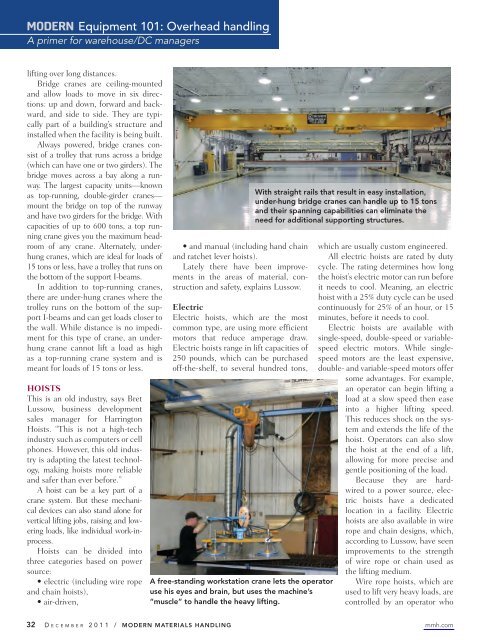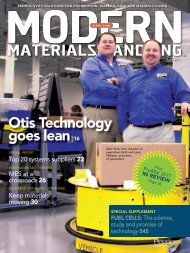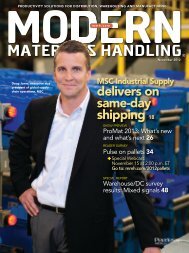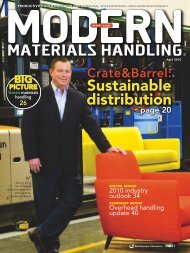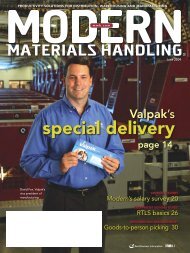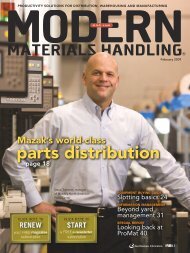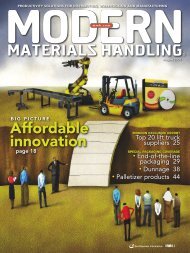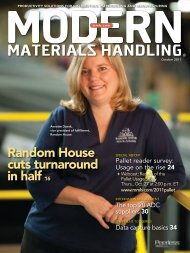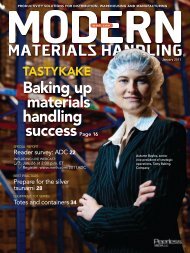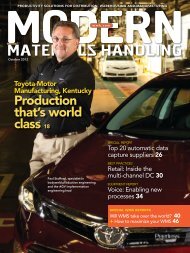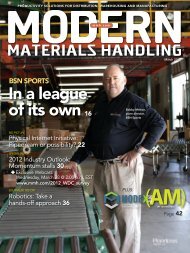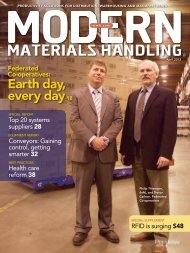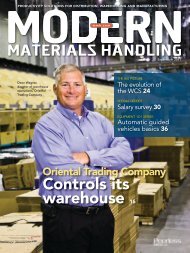Modern Materials Handling - December 2011
Modern Materials Handling - December 2011
Modern Materials Handling - December 2011
Create successful ePaper yourself
Turn your PDF publications into a flip-book with our unique Google optimized e-Paper software.
MODERN Equipment 101: Overhead handlingA primer for warehouse/DC managerslifting over long distances.Bridge cranes are ceiling-mountedand allow loads to move in six directions:up and down, forward and backward,and side to side. They are typicallypart of a building’s structure andinstalled when the facility is being built.Always powered, bridge cranes consistof a trolley that runs across a bridge(which can have one or two girders). Thebridge moves across a bay along a runway.The largest capacity units—knownas top-running, double-girder cranes—mount the bridge on top of the runwayand have two girders for the bridge. Withcapacities of up to 600 tons, a top runningcrane gives you the maximum headroomof any crane. Alternately, underhungcranes, which are ideal for loads of15 tons or less, have a trolley that runs onthe bottom of the support I-beams.In addition to top-running cranes,there are under-hung cranes where thetrolley runs on the bottom of the supportI-beams and can get loads closer tothe wall. While distance is no impedimentfor this type of crane, an underhungcrane cannot lift a load as highas a top-running crane system and ismeant for loads of 15 tons or less.HOISTSThis is an old industry, says BretLussow, business developmentsales manager for HarringtonHoists. “This is not a high-techindustry such as computers or cellphones. However, this old industryis adapting the latest technology,making hoists more reliableand safer than ever before.”A hoist can be a key part of acrane system. But these mechanicaldevices can also stand alone forvertical lifting jobs, raising and loweringloads, like individual work-inprocess.Hoists can be divided intothree categories based on powersource:• electric (including wire ropeand chain hoists),• air-driven,• and manual (including hand chainand ratchet lever hoists).Lately there have been improvementsin the areas of material, constructionand safety, explains Lussow.ElectricElectric hoists, which are the mostcommon type, are using more efficientmotors that reduce amperage draw.Electric hoists range in lift capacities of250 pounds, which can be purchasedoff-the-shelf, to several hundred tons,A free-standing workstation crane lets the operatoruse his eyes and brain, but uses the machine’s“muscle” to handle the heavy lifting.With straight rails that result in easy installation,under-hung bridge cranes can handle up to 15 tonsand their spanning capabilities can eliminate theneed for additional supporting structures.which are usually custom engineered.All electric hoists are rated by dutycycle. The rating determines how longthe hoist’s electric motor can run beforeit needs to cool. Meaning, an electrichoist with a 25% duty cycle can be usedcontinuously for 25% of an hour, or 15minutes, before it needs to cool.Electric hoists are available withsingle-speed, double-speed or variablespeedelectric motors. While singlespeedmotors are the least expensive,double- and variable-speed motors offersome advantages. For example,an operator can begin lifting aload at a slow speed then easeinto a higher lifting speed.This reduces shock on the systemand extends the life of thehoist. Operators can also slowthe hoist at the end of a lift,allowing for more precise andgentle positioning of the load.Because they are hardwiredto a power source, electrichoists have a dedicatedlocation in a facility. Electrichoists are also available in wirerope and chain designs, which,according to Lussow, have seenimprovements to the strengthof wire rope or chain used asthe lifting medium.Wire rope hoists, which areused to lift very heavy loads, arecontrolled by an operator who32 D E C E M B E R 2 0 1 1 / MODERN MATERIALS HANDLING mmh.com


